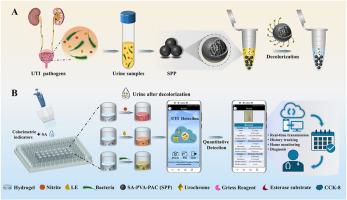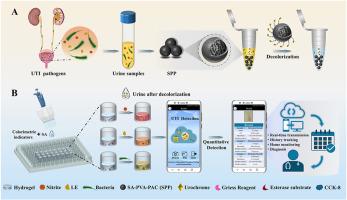Intelligent multi-index urine detection using colorimetric hydrogel for integrated urinary tract infections diagnosis
IF 6
2区 化学
Q1 CHEMISTRY, ANALYTICAL
引用次数: 0
Abstract
Background
Urinary tract infection (UTI) is a significant global health issue. Urine bacterial culture is time-consuming, prone to misdiagnosis, and the existing sample pretreatment methods are cumbersome, relying on centralized laboratories and specialized equipment. Colorimetric sensing provides a faster alternative. However, its accuracy is often compromised by the variable color of the patient's urine samples. Therefore, it is clear that a rapid, simple, gentle, and environmentally friendly pretreatment method is needed that effectively eliminates color interference in colorimetric detection and is compatible with smartphones, enabling real-time, quantitative on-site monitoring of UTI. (90)
Results
In this study, we describe a unique smartphone-assisted diagnostic method for quantifying nitrite, leukocyte esterase (LE), and bacteria in urine samples. The method employs activated carbon composite hydrogel spheres for urine pretreatment, which effectively removes background color interference and improves sensor performance, and combined with a smartphone-based microplate analyzer independently developed by our group previously, allows for precise colorimetric examination. This will aid in the prompt detection and dynamic monitoring of urinary tract infections in clinical settings. Furthermore, the bacterial detection time was shortened to 2 h, enhancing the accuracy and timeliness of the diagnostic process. The detection limits of nitrite, LE, and E. coli were 0.0584 mg L−1, 0.0775 Leu μL−1, and 2.94 CFU mL−1, respectively, meeting clinical requirements. Validation of 147 clinical samples indicated high consistency with the Sysmex UC-3500 Automatic Urine Analyzer, demonstrating the sensor's durability and accuracy. (141)
Significance
Activated carbon hydrogel beads with high adsorption properties were used for the pretreatment of urine samples for the first time, effectively removing background color interference in colorimetric detection. Integration of a smartphone-based microplate analyzer with a hydrogel slow-release system enables quantitative detection of nitrite, LE, and bacteria. This strategy offers a portable, low-cost solution for home-based UTI monitoring, enabling more timely management and appropriate administration of therapy to improve patient outcomes. (71)


比色水凝胶智能多指标尿液检测用于综合尿路感染诊断
尿路感染(UTI)是一个重要的全球健康问题。尿液细菌培养耗时长,容易误诊,现有的样品前处理方法繁琐,依赖集中实验室和专用设备。比色传感提供了一个更快的选择。然而,其准确性经常受到患者尿液样本颜色变化的影响。因此,需要一种快速、简单、温和、环保的预处理方法,有效消除比色检测中的颜色干扰,并与智能手机兼容,实现对UTI的实时、定量现场监测。(90)结果在本研究中,我们描述了一种独特的智能手机辅助诊断方法,用于定量尿液样本中的亚硝酸盐、白细胞酯酶(LE)和细菌。该方法采用活性炭复合水凝胶球对尿液进行预处理,有效地消除了背景色干扰,提高了传感器性能,并结合本课组前期自主研发的智能手机微孔板分析仪,实现了精准比色检测。这将有助于在临床环境中及时发现和动态监测尿路感染。将细菌检测时间缩短至2 h,提高了诊断过程的准确性和及时性。亚硝酸盐、LE和大肠杆菌的检出限分别为0.0584 mg L-1、0.0775 Leu μL-1和2.94 CFU mL-1,符合临床要求。对147个临床样本的验证表明,该传感器与Sysmex UC-3500自动尿液分析仪具有很高的一致性,证明了该传感器的耐用性和准确性。(141)意义首次将高吸附性能的活性炭水凝胶珠用于尿液样品的前处理,有效地消除了比色检测中的背景色干扰。基于智能手机的微孔板分析仪与水凝胶缓释系统的集成,可以定量检测亚硝酸盐,LE和细菌。该策略为家庭尿路感染监测提供了一种便携、低成本的解决方案,能够更及时地进行管理和适当地实施治疗,以改善患者的预后。(71)
本文章由计算机程序翻译,如有差异,请以英文原文为准。
求助全文
约1分钟内获得全文
求助全文
来源期刊

Analytica Chimica Acta
化学-分析化学
CiteScore
10.40
自引率
6.50%
发文量
1081
审稿时长
38 days
期刊介绍:
Analytica Chimica Acta has an open access mirror journal Analytica Chimica Acta: X, sharing the same aims and scope, editorial team, submission system and rigorous peer review.
Analytica Chimica Acta provides a forum for the rapid publication of original research, and critical, comprehensive reviews dealing with all aspects of fundamental and applied modern analytical chemistry. The journal welcomes the submission of research papers which report studies concerning the development of new and significant analytical methodologies. In determining the suitability of submitted articles for publication, particular scrutiny will be placed on the degree of novelty and impact of the research and the extent to which it adds to the existing body of knowledge in analytical chemistry.
 求助内容:
求助内容: 应助结果提醒方式:
应助结果提醒方式:


